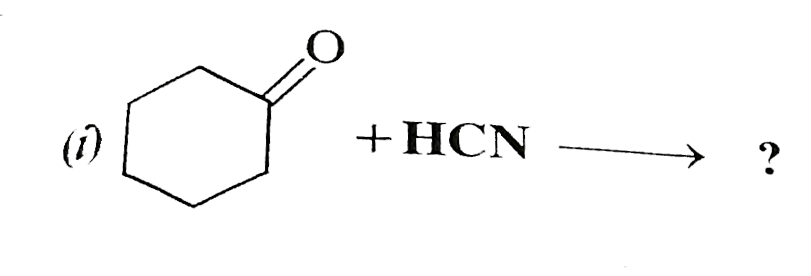Write the mechanism of the following reaction:
nBuBr + KCN EtOH−H2O−−−−−−−→ nBuCN
To understand the mechanism of the reaction between n-butyl bromide (nBuBr) and potassium cyanide (KCN) in the presence of ethanol and water (EtOH-H2O), we will follow the steps of the nucleophilic substitution reaction, specifically the SN2 mechanism.
1. Identify the Reactants and the Product:
- Reactants: n-butyl bromide (nBuBr) and potassium cyanide (KCN).
- Product: n-butyl cyanide (nBuCN).
2. Determine the Nucleophile:
- In KCN, the cyanide ion (CN⁻) acts as the nucleophile. This is the species that will attack the carbon atom in n-butyl bromide.
3. Mechanism Type:
- The reaction is a nucleophilic substitution reaction, specifically an SN2 mechanism. This type of reaction involves a single concerted step where the nucleophile attacks the substrate while the leaving group departs.
4. Structure of n-Butyl Bromide:
- The structure of n-butyl bromide is CH3-CH2-CH2-CH2-Br. The bromine atom is the leaving group.
5. Nucleophilic Attack:
- The cyanide ion (CN⁻) will attack the carbon atom that is bonded to the bromine. In the SN2 mechanism, the nucleophile attacks from the opposite side of the leaving group (bromine), leading to an inversion of configuration.
6. Formation of the Transition State:
- As the cyanide ion approaches the carbon atom, a transition state is formed where both the nucleophile and the leaving group are partially bonded to the carbon atom.
7. Departure of the Leaving Group:
- The bromine atom (Br) leaves, resulting in the formation of n-butyl cyanide (nBuCN). The final structure is CH3-CH2-CH2-CH2-CN.
8. Final Product:
- The product of the reaction is n-butyl cyanide (nBuCN), which is formed through the substitution of the bromine atom with the cyanide group.
Summary of the Mechanism:
- The reaction proceeds via an SN2 mechanism where the nucleophile (CN⁻) attacks the carbon atom of n-butyl bromide from the backside, leading to the inversion of configuration and the formation of n-butyl cyanide.
- Reactants: n-butyl bromide (nBuBr) and potassium cyanide (KCN).
- Product: n-butyl cyanide (nBuCN).
- In KCN, the cyanide ion (CN⁻) acts as the nucleophile. This is the species that will attack the carbon atom in n-butyl bromide.
- The reaction is a nucleophilic substitution reaction, specifically an SN2 mechanism. This type of reaction involves a single concerted step where the nucleophile attacks the substrate while the leaving group departs.
- The structure of n-butyl bromide is CH3-CH2-CH2-CH2-Br. The bromine atom is the leaving group.
- The cyanide ion (CN⁻) will attack the carbon atom that is bonded to the bromine. In the SN2 mechanism, the nucleophile attacks from the opposite side of the leaving group (bromine), leading to an inversion of configuration.
- As the cyanide ion approaches the carbon atom, a transition state is formed where both the nucleophile and the leaving group are partially bonded to the carbon atom.
- The bromine atom (Br) leaves, resulting in the formation of n-butyl cyanide (nBuCN). The final structure is CH3-CH2-CH2-CH2-CN.
- The product of the reaction is n-butyl cyanide (nBuCN), which is formed through the substitution of the bromine atom with the cyanide group.
- The reaction proceeds via an SN2 mechanism where the nucleophile (CN⁻) attacks the carbon atom of n-butyl bromide from the backside, leading to the inversion of configuration and the formation of n-butyl cyanide.
Similar Questions
Knowledge Check
In the following reaction 'A' is :
C2H5MgBr+epoxyethaneH2O−−→AAC2H5CH2CHOBC2H5CH2CH2OHCC2H5CH2OHDC2H5CHO
Explain the following reaction :
n−BuBr+KCNEtOH−H2O−−−−−−−→n−BuCN
View SolutionExplain the following reaction:
nBuBr+KCNEt-OH/H2O−−−−−−−→nBuCN
View SolutionWrite the mechanism of the following reaction
CH3CH2OHHBr−−→CH3CH2Br+H2O.
View SolutionExplain the mechanism of the following reaction:
CH3CH2OHH+−−→443KCH2=CH2+H2O
View SolutionWrite the products of following reactions
(a) CH3−C≡NH3O−−−−→ (b) CH3NCH3O+−−−→
View SolutionExplain the mechanism of the following reaction
2CH3CH2OH413K−−→C2H5−O−C2H5
View SolutionWrite the products of the following reactions :
(i)
(ii) CH3−CH=CH−CN(a)DiBAL−H−−−−−−−−−→(b)H2O?
View Solution
